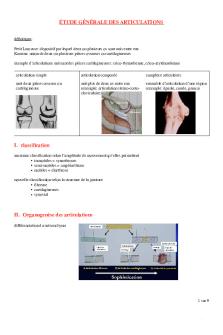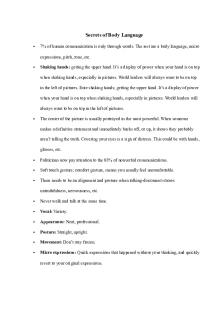Articulations and Body Movement PDF

| Title | Articulations and Body Movement |
|---|---|
| Course | Human Biology Lab |
| Institution | Indiana University - Purdue University Indianapolis |
| Pages | 4 |
| File Size | 116.5 KB |
| File Type | |
| Total Downloads | 39 |
| Total Views | 164 |
Summary
The goal of the lecture is understand rare exceptions of every bone and joint. Topics also discussed include --- classification of joints, synovial joints and their movements, and selected synovial joints. ...
Description
Articulations and Body Movements With rare exceptions, every bone in the body is connected to, or forms a joint with, at least one other bone. Articulations: Joints, perform functions for the body o Hold the bones together o Allow the rigid skeletal system some flexibility so that gross body movements can occur. Classification of Joints Classified structurally and functionally. o Structural classification is based on the type of connective tissue between the bones and the presence or absence of a joint cavity. Fibrous: adjoining bones connected by dense fibrous connective tissue; no joint cavity EX: between the tibia and fibula, tooth in a bony socket Synarthroses and Amphiarthrosis functional classifications Cartilaginous: Adjoining bones united by cartilage; no joint cavity EX: Intervertebral discs between adjacent vertebrae and the anterior connection between the pubic bones Synarthroses and Amphiarthroses functional classifications. Synovial Joints: Adjoining bones covered in articular cartilage; separated by a joint cavity and enclosed in an articular capsule lined with a synovial membrane. EX: Between the carpals of the wrist, elbow joint, shoulder joint Diarthrosis functional classifications only. o Functional classification focuses on the amount of movement allowed at the joint Synarthroses: immovable joints Amphiarthroses: slightly movable joints Diarthroses: freely moveable joints Types of Joints o Joints to the left of the skeleton are cartilaginous joints – joints above and below the skeleton are fibrous joints. o Joints to the right of the skeleton are synovial joints Joint between costal cartilage of rib 1 and sternum Intervertebral discs of fibrocartilage connecting adjacent vertebra Fibrocartilaginous pubic symphysis connecting the pubic bones anteriorly Dense fibrous connective tissue connecting interlocking skull bones Ligament of dense regular connective tissue connecting the inferior ends of the tibia and fibula Shoulder joint Elbow joint Wrist joint Synovial Joints Joints in which the articulating bone ends are separated by a joint cavity containing synovial fluid. All synovial joints are diarthroses, or freely movable joints. Most joints in the body are synovial joints. Typically have the following structural characteristics o Joint (articular) cavity: a space between the articulating bones that contains a small amount of synovial fluid o Articular cartilage: Hyaline cartilage that covers the surface of bones forming the joint o Articular capsule: two layers that enclose the joint cavity. The tough external layer is the fibrous layer composed of dense irregular connective tissue. The inner layer is the synovial membrane composed of loose connective tissue o Synovial fluid: A viscous fluid, the consistency of egg white, located in the joint cavity and the articular cartilage. This fluid acts as a lubricant, reducing friction. o Reinforcing ligaments: Some joints are reinforced by ligaments.
Most ligaments are capsular ligaments, which are thickenings of the fibrous layer of the articular capsule. Some ligaments are extracapsular, found outside the articular capsule. Intracapsular ligaments are found within the articular capsule. o Nerves and blood vessels: Sensory nerve fibers detect pain and joint stretching. Most of the blood vessels supply the synovial membrane. o Articular discs: Pads composed of fibrocartilage (menisci) may also be present to minimize wear and tear on the bone surfaces. o Bursa and tendon sheath: Sac filled with synovial fluid that reduces friction where ligaments, muscles, skin, tendons, and bones rub together. A tendon sheath is an elongated bursa that wraps around a tendon like a bun around a hot dog. Types of Synovial Joints o The many types of synovial joints can be subdivided according to their function and structure. Shapes of the articular surfaces determine the types of movements that can occur at the joint. Determine the structural classification of the joints o Plate: Flat or slightly curved bones o Hinge: A rounded or cylindrical bone fits into a concave surface on the other bone o Pivot: A rounded bone fits into a sleeve (a concave bone plus a ligament) o Condylar: An oval condyle fits into an oval depression on the other bone o Saddle: Articulating surfaces are saddle shaped; one surface is concave, the other surface is convex o Ball-and-socket: The ball-shaped head of one bone fits into the cup-like depression of the other one. o Articulating bones Intercarpal joint Elbow Proximal radioulnar joint Metacarpophalangeal joint Carpometacarpal joint of the thumb Shoulder Movements Allowed by Synovial Joints Every muscles of the body is attached to bone (or other connective tissue structures) at two points o Origin: stationary, immovable, or less moveable bone o Insertion: movable bone. Body movement occurs when muscles contract across diarthrotic synovial joints o When the muscle contracts and its fibers shorten, the insertion moves toward the origin o The type of movement depends on the construction of the joint and on the placement of the muscle relative to the joint. Most common types: Flexion, extension, and hyperextension of the neck Flexion, extension, and hyperextension of the vertebral column Flexion and extension at the shoulder and knee, and hypertension of the shoulder Abduction, adduction, and circumduction of the upper limb at the shoulder Rotation of the head and lower limb Pronation and supination of the forearm Dorsiflexion and planter flexion of the foot Inversion and eversion of the foot o Flexion: A movement, generally in the sagittal plane, that decreases the angles of the joint and reduces the distances between the two bones Typical of hinge joints (bending the knee or elbow) but is also common at ball-and-socket joints (bending forward at the hip) o Extension: A movement that increases the angle of a joint and the distance between two bones or parts of the body; the opposite of flexion.
If extension proceeds beyond anatomical position (bends the trunk backward), it is termed hyperextension. o Abduction: Movement of a limb away from the middle of the body, along the frontal plane, or the fanning movement of fingers or toes when they are spread apart o Adduction: Movement of a limb toward the midline of the body or drawing the fingers or toes together Opposite of abduction o Rotation: Movement of a bone around its longitudinal axis without lateral or medial displacement. Rotation, a common movement of ball-and-socket joints, also describes the movement of the atlas around the dens of the axis. o Circumduction: A combination of flexion, extension, abduction, and adduction commonly observed in ball-and-socket joints like the shoulder. The limb as a whole outline a cone. o Pronation: Movement of the palm of the hand from an anterior or upward-facing position to a posterior or downward-facing position. The distal end of the radius rotates over the ulna so that the bones form an X with pronation. During supination, the radius and ulna are parallel. o Supination: Movement of the palm from a posterior position to an anterior position (the anatomical position) Opposite of pronation During supination, the radius and ulna are parallel. o Refer to movements of the foot: Dorsiflexion: A movement of the ankle joint that lifts the foot so that it’s superior surface approaches the shin. Plantar flexion: A movement of the ankle joint in which the foot is flexed downward as if standing on one’s toes or pointing the toes. Inversion: A movement that turns the sole of the foot medically. Eversion: A movement that turns the sole of the foot laterally Opposite of inversion. Selected Synovial Joints The Hip and Knee Joints o Both joints are large weight-bearing joints of the lower limb, but they differ substantially in their security. The Hip Joint o A ball-and-socket joint, so movements can occur in all possible planes. o Movements are definitely limited by its deep socket and strong reinforcing ligaments, the two factors that account for its exceptional stability. o Acetabular labrum: the deeply cupped acetabulum that receives the head of the femur is enhanced by a circular rim of fibrocartilage Because the diameter of the labrum is smaller than that of the femur’s head, dislocations of the hip are rare. o Ligament of the head of the femur: Short ligament runs from the pit-like fovea capitis on the femur head to the acetabulum where it helps to secure the femur. o Strong ligaments that spirals posteriorly, arranged so they can “screw” the femur head into the socket when a person stands upright. Iliofemoral Pubofemoral anteriorly Ischiofemoral The Knee Joint o The knee is the largest and most complex joint in the body. o Three joints in one allows: Extension, flexion Little rotation o Tibiofemoral joint: actually, a biocondyloid joint between the femoral condyles above and the menisci (semilunar cartilages) of the tibia
o o o
o
o o
Functionally a huge joint Very unstable one made slightly more secure by the menisci Some rotation occurs when the knee is partly flexed, but during extension, the menisci and ligaments counteract rotation and side-to-side movements Femoropatellar joint: intermediate joint anteriorly The knee is unique in that it is only partly enclosed by an articular capsule Anteriorly, where the capsule is absent, are three broad ligaments that runs from the patella to the tibia below and merge with the capsule on either side. Patellar ligament Medial patellar retinacula Lateral patellar retinacula Extra capsular ligaments are crucial in reinforcing the knee Fibular and tibial collateral ligaments (prevent rotation during extension) Oblique popliteal Arcuate popliteal ligaments The knees have a built-in locking device that must by “unlocked” by the popliteus muscles before knees can be flexed again. The anterior and posterior cruciate ligaments are intracapsular ligaments that cross (cruci = cross) in the notch between the femoral condyles Help prevent anterior-posterior displacement of the joint and overflexion and hyperextension of the joint....
Similar Free PDFs

Articulations and Body Movement
- 4 Pages

Biomechanics and Body Movement
- 17 Pages

Articulations
- 9 Pages

Chapter 12 Control of Body Movement
- 23 Pages

Bhakti and Sufi Movement
- 4 Pages

Ch. - Articulations
- 6 Pages

Body Organization and Homeostasis
- 14 Pages

Articulations du bassin
- 4 Pages

Speech and Body Language
- 2 Pages

Human Movement and the Sciences
- 12 Pages
Popular Institutions
- Tinajero National High School - Annex
- Politeknik Caltex Riau
- Yokohama City University
- SGT University
- University of Al-Qadisiyah
- Divine Word College of Vigan
- Techniek College Rotterdam
- Universidade de Santiago
- Universiti Teknologi MARA Cawangan Johor Kampus Pasir Gudang
- Poltekkes Kemenkes Yogyakarta
- Baguio City National High School
- Colegio san marcos
- preparatoria uno
- Centro de Bachillerato Tecnológico Industrial y de Servicios No. 107
- Dalian Maritime University
- Quang Trung Secondary School
- Colegio Tecnológico en Informática
- Corporación Regional de Educación Superior
- Grupo CEDVA
- Dar Al Uloom University
- Centro de Estudios Preuniversitarios de la Universidad Nacional de Ingeniería
- 上智大学
- Aakash International School, Nuna Majara
- San Felipe Neri Catholic School
- Kang Chiao International School - New Taipei City
- Misamis Occidental National High School
- Institución Educativa Escuela Normal Juan Ladrilleros
- Kolehiyo ng Pantukan
- Batanes State College
- Instituto Continental
- Sekolah Menengah Kejuruan Kesehatan Kaltara (Tarakan)
- Colegio de La Inmaculada Concepcion - Cebu





